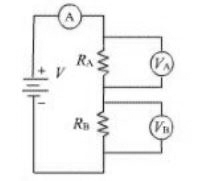
(a)
the current in the circuit.
(a)
Answer to Problem 7PP
The current in the circuit is 66.7 mA.
Explanation of Solution
Given:
The circuit diagram is

Formula:
The expression for potential is given by
Here,
Calculation:
Voltage drop
Solve for
Substitute the values in equation (2)
Thus, the current in the circuit is 66.7 mA.
Conclusion:
Hence, the required voltage drop across the 22
(b)
the potential difference across the battery.
(b)
Answer to Problem 7PP
The required voltage drop across the voltage is 36.5 V.
Explanation of Solution
Given:
Reading of ammeter is
Resistance is
Resistance is
Formula:
The expression for potential is given by
Here,
Calculation:
The equivalent resistance is the sum of the resistance that is,
Substitute the values,
Now, substitute in equation (1)
Conclusion:
Hence, the required voltage drop across the voltage is 36.5 V.
(c)
the total power used in the circuit and power used in each resistor.
(c)
Answer to Problem 7PP
Power dissipation is
Explanation of Solution
Given:
Reading of ammeter is
Resistance is
Resistance is
Voltage drop across the 15
Voltage drop across the 22
Formula:
Power is given by the expression
Here,
Calculation:
From path (a) and (b),
Substitute the values in equation (1)
Power dissipation across the resistor
Substitute the values in equation (2)
Similarly,
Power dissipation across the resistor
The voltage drop
Substitute the values in equation (3)
Conclusion:
Hence, the required power dissipation is
(d)
whether sum of the power used in each resistor in the circuit equal to the total power used in the circuit.
(d)
Answer to Problem 7PP
The rate at which energy is converted or power is dissipated will equal to the sum of parts.
Explanation of Solution
Given:
Reading of ammeter is
Resistance is
Resistance is
Voltage drop across the 15
Voltage drop across the 22
Total power dissipation is
Individual power dissipation are 1.13 W and 1.30 W.
Calculation:
The sum of the individual power dissipation is 1.13 W + 1.30 W = 2.43 W.
Thus, the sum of the individual power dissipation in the circuit equals the total power dissipation in the circuit and thereby the total power is conserved.
Conclusion:
Hence, the rate at which energy is converted or power is dissipated will equal to the sum of parts.
Chapter 23 Solutions
Glencoe Physics: Principles and Problems, Student Edition
Additional Science Textbook Solutions
Sears And Zemansky's University Physics With Modern Physics
Lecture- Tutorials for Introductory Astronomy
University Physics with Modern Physics (14th Edition)
College Physics (10th Edition)
University Physics Volume 1
Tutorials in Introductory Physics
 College PhysicsPhysicsISBN:9781305952300Author:Raymond A. Serway, Chris VuillePublisher:Cengage Learning
College PhysicsPhysicsISBN:9781305952300Author:Raymond A. Serway, Chris VuillePublisher:Cengage Learning University Physics (14th Edition)PhysicsISBN:9780133969290Author:Hugh D. Young, Roger A. FreedmanPublisher:PEARSON
University Physics (14th Edition)PhysicsISBN:9780133969290Author:Hugh D. Young, Roger A. FreedmanPublisher:PEARSON Introduction To Quantum MechanicsPhysicsISBN:9781107189638Author:Griffiths, David J., Schroeter, Darrell F.Publisher:Cambridge University Press
Introduction To Quantum MechanicsPhysicsISBN:9781107189638Author:Griffiths, David J., Schroeter, Darrell F.Publisher:Cambridge University Press Physics for Scientists and EngineersPhysicsISBN:9781337553278Author:Raymond A. Serway, John W. JewettPublisher:Cengage Learning
Physics for Scientists and EngineersPhysicsISBN:9781337553278Author:Raymond A. Serway, John W. JewettPublisher:Cengage Learning Lecture- Tutorials for Introductory AstronomyPhysicsISBN:9780321820464Author:Edward E. Prather, Tim P. Slater, Jeff P. Adams, Gina BrissendenPublisher:Addison-Wesley
Lecture- Tutorials for Introductory AstronomyPhysicsISBN:9780321820464Author:Edward E. Prather, Tim P. Slater, Jeff P. Adams, Gina BrissendenPublisher:Addison-Wesley College Physics: A Strategic Approach (4th Editio...PhysicsISBN:9780134609034Author:Randall D. Knight (Professor Emeritus), Brian Jones, Stuart FieldPublisher:PEARSON
College Physics: A Strategic Approach (4th Editio...PhysicsISBN:9780134609034Author:Randall D. Knight (Professor Emeritus), Brian Jones, Stuart FieldPublisher:PEARSON





